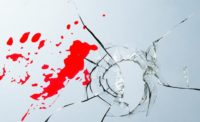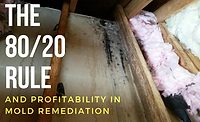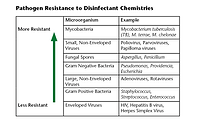4 Shifts That Can Affect Your Relationship with Clients and Potential Customers

The art of analyzing data has made it possible to spot trends and predict the near-term future. By examining patterns and what’s about to happen, governments and businesses are making decisions on how to prepare for what people will do and where they will spend money. But you don’t need to hire a big data consultant to recognize some of the trends that are already impacting the restoration and remediation industry.
During recent conversations with colleagues who are in the forefront of our industry, it occurred to me that many of us are so busy taking care of everyday business, it might be helpful to share what some of these thought leaders are seeing. At the end of each section below, I’ve posed questions in bold italics to prompt you to consider how you can be a step ahead of your customers and be better prepared to do business with them. Go ahead and check out the questions to see if the paragraph that precedes it will be of interest to you.
Shift Happens - Are you Ready?
Before the pandemic, many people were willing to hire a restoration professional to address a sizeable bio-contamination issue in their home or workplace. They were unlikely to consider doing the remediation job themselves. Their knowledge of sanitizers and disinfectants was mostly limited to their infrequent use of consumer products and most people felt pretty good after using a product that “kills 99.9% of germs”. Their decision-making process on who to hire to remediate mold or to address the sewage backflow had much to do with who provided the lowest bid and perhaps a personal reference. COVID-19 has changed a lot of people – your clients and potential customers - in the following ways:
Shift 1: If the job involves bio-contamination, your clients and potential customers are more informed about what they are hiring you to do.
This year, many people had a lot of time to increase their understanding about how disease is spread and many of them, particularly younger adults, are willing to educate themselves and try addressing bio-contamination issues themselves. Concerns about COVID-19 have driven an exponential increase in access to information on addressing biohazards. From postings in social media to guidance from government and public service organizations and articles from more traditional news outlets, there is a lot more information out there – some of it is helpful and some of it is just plain wrong. Even so, people have made significant progress “connecting the dots” with respect to protecting themselves against SARS-CoV-2. They’ve learned the principles behind proper cleaning and disinfection and are increasing their understanding of how things are supposed to be done – knowledge that in past years restoration professionals learned from professional consultants and organizations like RIA, GBAC/ISSA, IICRC, and others. These people - your clients and potential customers - are asking more detailed questions and expecting answers that make sense.

Are you and your teammates ready to address questions that require you to explain not just what you are going to do, but why you’re going to do it that way?
Shift 2: Your clients and potential customers know a lot more about disinfectants and how to apply them.
Fortunately, more reliable information about how to effectively address pathogens is being made available. Earlier in the year, manufacturers of electrostatic sprayers and foggers experienced a record increase in sales after news reporters showed workers in PPE walking down the aisle of a passenger plane or walking through a classroom waving around a machine that pumped out a disinfectant mist. At that time, it made sense to most people that if a disinfectant could “kill COVID-19”, spraying that disinfectant everywhere would be helpful. Machines would make it easier to cover a wider area with the same amount of liquid to make a good thing go farther. As the pandemic spread, the public became aware of the EPA’s List N, learned about a disinfectant’s dwell time, and why the dwell time is important. Becoming more informed, their expectations regarding which products would be used in their home or workplace, as well as how the disinfectant would be applied, has increased.
Have you reviewed your application methods and disinfectant labels to ensure you and your teammates are achieving the dwell time that is needed to deliver the intended results? Are you and your teammates ready to explain why you’re using the application method you propose?

Shift 3: Your clients and potential customers are more concerned about the chemicals you’re using and how those chemicals will affect them and the environment.
A trend that continues to develop is the movement toward disinfectants that have no adverse impact on occupants of the venue. Potential clients are asking about EPA Toxicity Category ratings of disinfectants, as well as if a disinfectant can be used on food-contact surfaces without having to rinse away the residue after application. Awareness of botanical products has been growing for several years and more recently, there has been a shift away from quaternary ammonium compounds (quats) driven by state and local governments on the West Coast.
Commonly used in the food service industry and in healthcare facilities, quats provide an economical means of disinfecting on a large scale because they often are sold as concentrates. Institutions such as hospitals and long-term care facilities have quat dispensers installed in housekeepers’ closets to properly and consistently generate the use dilution. However, when a concentrate is diluted by a person instead of a calibrated dispensing machine - and when a measuring cup is not used to add the exact amount of concentrate needed – more often than not the use dilution concentration is improper. When the concentration is too weak, the performance of the product is degraded. When it is too strong, the disinfectant can become more hazardous.
Since the reopening of schools this fall, a substantial increase in rashes and chemical burns on students has been traced back to widespread application of quat disinfectants that were improperly diluted, resulting in a disinfectant that was too strong. An increase in respiratory distress among students and concerns about downstream adverse impact on aquatic life is now driving a move away from quats in a number of West Coast municipalities.
If you and your team are using a disinfectant that is sold as a concentrate, are you taking the steps needed to ensure that the use dilution is of the proper concentration? Are you prepared to explain why the disinfectant you’ve used is the best choice for what you’re being hired to do and how it won’t adversely affect the health of building occupants or the environment?
Shift 4: Your clients and potential customers are more willing than ever before to make changes that improve their safety, and their expectations will continue to shift.
Restoration and remediation companies can be an integral part of a client’s safety plan. Just as the security of a home is not solely dependent on an alarm system and the alarm monitoring company, your client’s safety can be enhanced by services offered by your restoration company. When people are concerned about the security of their home, they will utilize a systematic approach to improving security by taking actions such as closing their garage door, utilizing timers or smart home devices for turning on and off lights, and limiting the number of people with knowledge of their plans to be away from home.
As clients have developed and implemented plans to return to work and reopen businesses, and as they learn more about what they need (and don’t need) to do, restoration companies are in a position to offer meaningful support. Early in the pandemic, some restoration companies were engaged to provide scheduled decontamination of businesses and common areas in multi-family housing, but much of that business has gone away as people have figured out what to do themselves to sustain “normal” business operations.
Until practical and effective mitigation of the virus that causes the COVID-19 infection is in place, opportunities for restoration companies to be engaged by clients will remain. Over time this paradigm is likely to shift.

Are your clients still inclined to call when their venue has been exposed to someone with an active case of COVID-19? Is there an ongoing role your company can play in delivering a safer workplace, or will your company just be called when there’s a traditional restoration and remediation event?
In every catastrophic event, there is both hardship and opportunity. Restoration and remediation professionals are accustomed to working through adversity, delivering relief to clients and rebuilding lives and communities. I’d like to thank several colleagues from our industry for contributing content and input for this article:
Derrick Denis, CIAQP, CAC, CIEC
Vice President of Indoor Environmental Quality
Clark Seif Clark, Inc.
John Anton
Founder and Partner
Bioesque Solutions
Mark Wiencek, PhD
Lead Microbiologist
Contec, Inc.
Looking for a reprint of this article?
From high-res PDFs to custom plaques, order your copy today!








